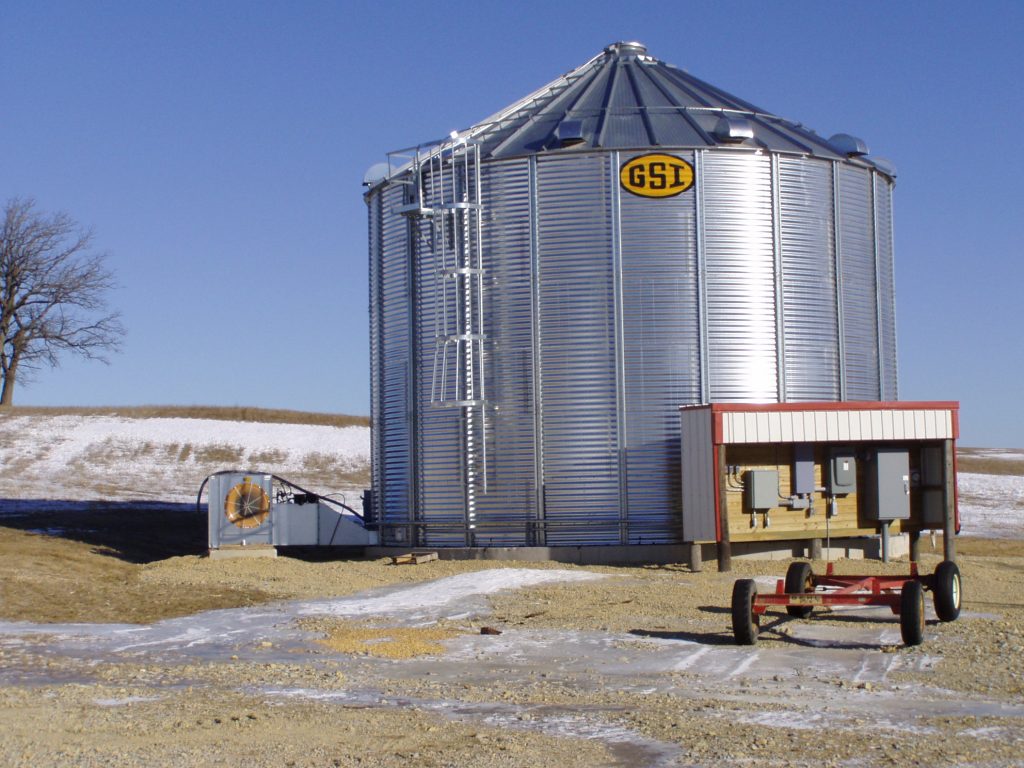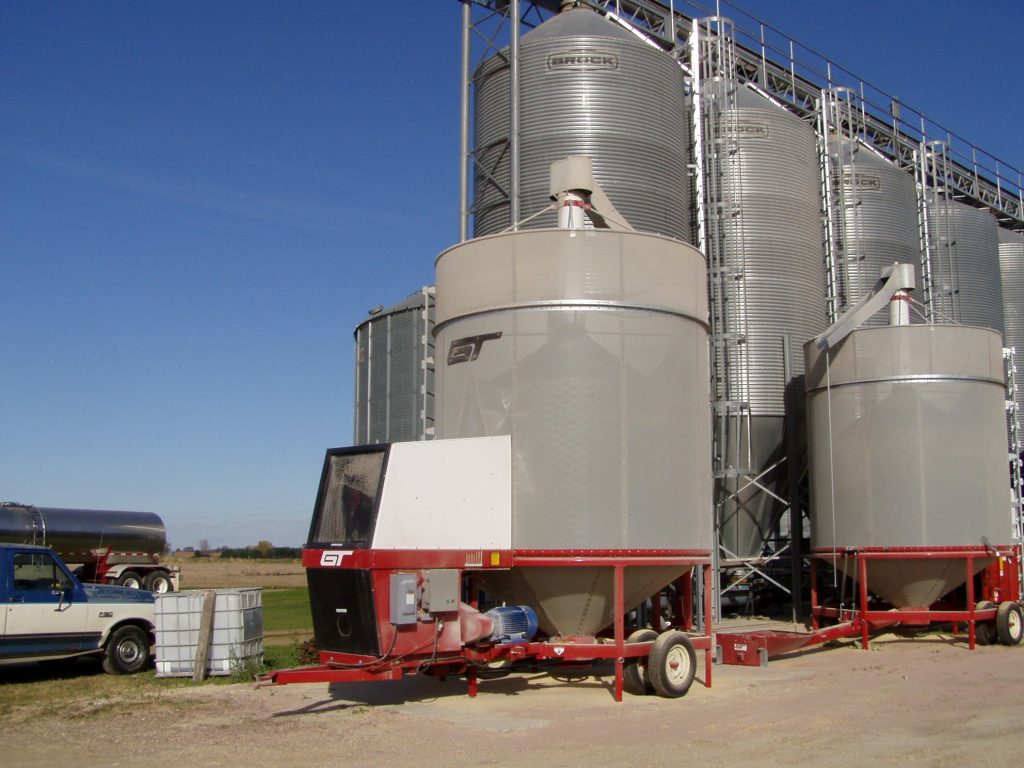Batch Bin Dryers
 This is the simplest dryer requiring a storage bin with a perforated floor and a blower to move air through the grain. If the grain from the field is less than 20 to 22% moisture, the grain can be dried with just ambient air providing there is enough air flow. The grain should be screened before filling the bin and drying in layers of 2 to 3 feet at a time will decrease drying times. Ideally, if multiple bins are available, each bin can be filled with a layer of grain before adding more to the first bin filled. Air flow rates need to be 1.25 cubic feet per minute or higher for Wisconsin. During a fall with low humidity, ambient drying will have the highest energy efficiency although it will all be electrical energy. During a fall with damp weather, the grain may not be dried down to storage moisture until spring which will greatly reduce the energy efficiency. If the weather is warm and the grain is high in moisture (20 %+) spoilage can be of concern. To reduce the risk of spoilage and long drying times, a small amount of heat can be introduce with a small resistance heater or a solar collector. Generally the air temperatures are increased up to a maximum of 10°F by these methods while drying times can be reduced significantly especially during damp fall weather where relative humidity exceeds 80%.
This is the simplest dryer requiring a storage bin with a perforated floor and a blower to move air through the grain. If the grain from the field is less than 20 to 22% moisture, the grain can be dried with just ambient air providing there is enough air flow. The grain should be screened before filling the bin and drying in layers of 2 to 3 feet at a time will decrease drying times. Ideally, if multiple bins are available, each bin can be filled with a layer of grain before adding more to the first bin filled. Air flow rates need to be 1.25 cubic feet per minute or higher for Wisconsin. During a fall with low humidity, ambient drying will have the highest energy efficiency although it will all be electrical energy. During a fall with damp weather, the grain may not be dried down to storage moisture until spring which will greatly reduce the energy efficiency. If the weather is warm and the grain is high in moisture (20 %+) spoilage can be of concern. To reduce the risk of spoilage and long drying times, a small amount of heat can be introduce with a small resistance heater or a solar collector. Generally the air temperatures are increased up to a maximum of 10°F by these methods while drying times can be reduced significantly especially during damp fall weather where relative humidity exceeds 80%.
High Temperature Bin dryer
This type of dryer uses the same equipment as the ambient dryer with the addition of propane or natural gas fired heating units. The largest disadvantage of this dryer type is over drying of grain; in order to get the grain on top dry, the grain on the bottom is over dried. This reduces grain weigh and increases energy use. If delayed cooling is not used there will be increases kernel stress cracks and brittleness. Stirring equipment can reduce the moisture variation, decrease drying times and reduce energy costs by up to 25%. Unless high capacity conveying equipment is used, usually only one batch per day can be dried and unloaded from a bin dryer.
Roof Dryers
As the name implies, the dryer is in the roof area of a bin. The grain is piled on top of a perforated floor under the bin roof for drying. Once the grain is dried, the grain is dropped to the bin floor by opening doors in the perforated floors. The advantage of this is faster cycle times by reducing unloading times. The grain that has been dropped to the bin floor is then cooled while the next batch is loaded into the roof drying bin.
Recirculating Batch Dryers
 These are typically small portable dryers that have a central plenum with a column of grain encircling the plenum. They can be manually or automatically loaded and unloaded. Some are powered from a tractor PTO which allows them to be used almost anywhere. The major disadvantage is they require more supervision and labor per bushel than other types of dryers. A well operated batch dryer has approximately the same energy efficiency as a continuous cross flow dryer with cooling section heat recovery.
These are typically small portable dryers that have a central plenum with a column of grain encircling the plenum. They can be manually or automatically loaded and unloaded. Some are powered from a tractor PTO which allows them to be used almost anywhere. The major disadvantage is they require more supervision and labor per bushel than other types of dryers. A well operated batch dryer has approximately the same energy efficiency as a continuous cross flow dryer with cooling section heat recovery.
Bulletin on Batch Dryers.
If you have questions about the information on this site, please contact
Scott Sanford, Distinguished Outreach Specialist, University of Wisconsin, sasanford@wisc.edu.



